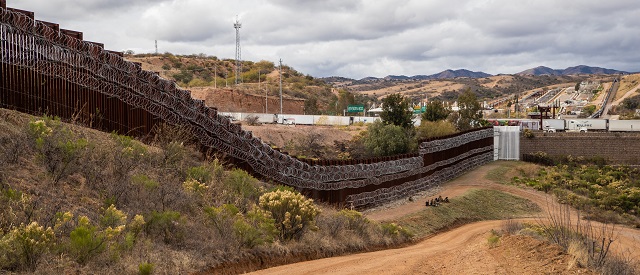illegal immigration
Surge In ‘Inadmissible’ Afghans Trying To Cross Southern Border Is Nothing Short Of Alarming

 From the Daily Caller News Foundation
From the Daily Caller News Foundation
There is good reason for Americans to be concerned about individuals from Afghanistan coming across our southern border.
When Gen. Michael Kurilla, commander of U.S. Central Command, testified in the Senate Armed Services Committee on March 7 he issued a warning about ISIS-K, a terrorist group based in Afghanistan.
“[V]arious groups in the Central Region retain the capability and will to target U.S. interests abroad in under six months with little to no warning,” Kurilla said in a written statement to the committee.
“We assess an attack on American soil would likely take longer,” he said.
“Taliban pressure against ISIS-K temporarily disrupted the group’s ability to plan and conduct attacks against the Homeland and Western targets, but that pressure has been intermittent and insufficient,” Kurilla said in his statement.
“ISIS-K and its allies retain a safe haven in Afghanistan, and they continue to develop their networks in and out of the country,” he said.
“Their goals do not stop there,” he said.
“They have called for attacks globally on anyone not aligned with their extremist ideology, and Taliban efforts to suppress the group have proven insufficient,” he said. “The recent ISIS attack in Kerman, Iran demonstrates the group’s resiliency and indicates that they retain the capability to conduct spectacular external operations.”
What happened in Kerman?
“ISIS-K killed 91 Iranians and injured 284 others in Kerman on 3 January 2024,” Kurilla said. “This was the deadliest terror attack in Iran since 1979 and it is part of ISIS’ effort to exploit the war in Gaza to rejuvenate its global attacks.”
ISIS-K is not the only terrorist group in Afghanistan.
“Al Qaeda, while weakened, still enjoys safe havens in Afghanistan and Yemen. Al Qaeda in the Indian Subcontinent (AQIS) operates training camps, safehouses, and religious schools in Afghanistan,” he said.
“Both AQIS and AQAP [Al Qaeda in the Arabian Peninsula] continue to call for lone wolf attacks on U.S. and Western interests via their digital reach,” he said.
Republican Sen. Tom Cotton of Arkansas, who served as a U.S. Army officer in Afghanistan, questioned Kurilla about what he had said about ISIS and al-Qaeda.
In this exchange, Kurilla said an ISIS attack in Europe or Eurasia is more likely in the near future than one in the United States itself.
“You said — and this is close to a direct quote — that we could see attacks against U.S. or Western interests abroad with little to no warning in as little as six months,” Cotton said. “Are you speaking there about ISIS and al-Qaeda from Afghanistan?”
Kurilla responded: “ISIS-Khorasan specifically, and also out of Syria, which they are trying to factor into predominantly European countries.”
“So,” said Cotton, “ISIS out of either Afghanistan or Syria, attacks against U.S. interests and Western interests abroad in as little as six months. Now, abroad can mean a lot of things. Abroad could mean our embassy in Tajikistan. It could also mean Western Europe or North America.
“Could you be more specific?” Cotton asked.
“Europe and Eurasia,” said Kurilla.
“What is the timeline you foresee in which those terrorist organizations could launch an attack with little or no warning against the American homeland?” asked Cotton.
“I think it is … a lot more difficult for them to be able to do that and requires substantially more resources,” responded Kurilla.
“OK,” said Cotton, “so six months anywhere across Eurasia and indeterminate time in North America?”
“Yes,” said CENTCOM’s commander.
When Kurilla had testified in the Senate Armed Services Committee in March 2023, he admitted that U.S. intelligence gathering in Iraq had diminished.
“At one time, we had 60 balloons over Kabul, Afghanistan,” Republican Sen. Tommy Tuberville of Alabama said to Kurilla then. “Our ISR [intelligence, surveillance, reconnaissance] is very limited. How confident are you in the intelligence you have to see threats rising from the Taliban?”
“Our intelligence has degraded since we are no longer in Afghanistan,” Kurilla said. “I believe we can see the broad contours of an attack. Sometimes we lack the granularity to see the full picture and we’re working to close that gap with our alternative airborne ISR and some of our other intelligence that we are working to penetrate those networks.”
Since this nation’s military forces were withdrawn from Afghanistan in 2021, the Biden administration has been conducting “Operation Enduring Sentinel.” Last month, the inspectors general for this operation released their report for the first quarter of 2024.
Operation Enduring Sentinel, it explains, is “the U.S. mission to conduct over-the-horizon counterterrorism operations against threats emanating from Afghanistan and to engage with Central Asian and South Asian regional partners to combat terrorism and promote regional stability.”
The United States, of course, is continuing to accept refugee applications from people fleeing the situation in Afghanistan. “From October 1, 2020, to March 6, 2024, USCIS interviewed approximately 24,400 Afghan refugee applicants,” said the inspectors general report.
Then there are those who are not refugee applicants.
“In addition,” said the report, “U.S. Customs and Border Protection (CBP) encountered 68 Afghan ‘inadmissible non-citizens’ at the U.S. Southwest Border in FY 2022 and 342 in FY 2023.
“As of March 5,” it said, “CBP had encountered 932 in FY 2024.”
How many “inadmissible non-citizen” Afghans made it across the southwest border in those first 156 days of this fiscal year without being encountered by the Border Patrol?
It only took 19 al-Qaeda terrorists to carry out the 9/11 attack.
Terence P. Jeffrey is the investigative editor of the Daily Caller News Foundation. To find out more about Terence P. Jeffrey and read features by other Creators Syndicate writers and cartoonists, visit the Creators Syndicate website at www.creators.com.
Daily Caller
Tom Homan Predicts Deportation Of Most Third World Migrants Over Risks From Screening Docs


From the Daily Caller News Foundation
White House border czar Tom Homan predicted Sunday the Trump administration will deport the majority of Third World migrants due to vetting challenges.
Two National Guardsmen were shot Wednesday, allegedly by an Afghan national brought into the U.S. under the Biden administration. The attack prompted President Donald Trump to announce in a Thursday post on Truth Social that his administration would “permanently pause migration from all Third World Countries.” Homan said on Fox News’s “Sunday Morning Futures” that Third World nations could not be relied upon to provide accurate information for vetting migrants.
Dear Readers:
As a nonprofit, we are dependent on the generosity of our readers.
Please consider making a small donation of any amount here.
Thank you!
“[T]hese Third World nations, they don’t have systems like we do. So, a lot of these Afghanistans, when they did get here and get vetted, they had no identification at all. Not a single travel document, not one piece of identification,” Homan said. “And we’re going to count on the people that run Afghanistan, the Taliban, to provide us any information [on] who the bad guys were or who the good guys are? Certainly not. And many people need to understand that most terrorists in this world, most of ’em, aren’t in any database.”
“And the same thing with illegal aliens, the over 10 million that came across the border under Joe Biden. There’s no way to vet these people. You think El Salvador or Turkey or Sudan or any of these countries have the databases or system checks that we have?” he added. “Do you think the government[s] of China, Russia, Turkey, do you think they’re going to share that data with us even if they did have it? There’s no way to clearly vet these people 100% that they’re safe to come to this country from these Third World nations.”
The president also wrote in his Thursday post he would “terminate all of the millions of Biden illegal admissions,” along with deporting those who do not offer value to the United States. Homan said Trump is correct to evaluate all migrants who entered under Biden.
“I really, truly think that most of ’em are [going to] end up being deported ’cause we’re not going to be able to properly vet them,” he said.
Similarly, Homeland Security Secretary Kristi Noem asserted Sunday on NBC News’s “Meet the Press” the Trump administration would deport individuals with pending asylum claims.
West Virginia Army National Guard Specialist Sarah Beckstrom, 20, perished Thursday from wounds sustained in Wednesday’s shooting. The other victim, Air Force Staff Sgt. Andrew Wolfe, remains in critical condition at the time of publication.
The shooting was allegedly carried out by Rahmanullah Lakanwal, who entered the country in September 2021 after the U.S. military’s withdrawal from Afghanistan. Lakanwal previously worked with the U.S. government, including the CIA, and was admitted into the U.S. under the Biden administration’s Operation Allies Welcome, which resettled Afghans who had helped American forces.
Lakanwal applied for asylum in 2024, which the Trump administration granted in April 2025, according to Reuters. The alleged gunman shouted, “Allahu akbar!” before opening fire with a revolver, independent journalist Julio Rojas reported.
As of December 2024, over 180,000 Afghans were resettled in the U.S. following its August 2021 withdrawal, according to the State Department. After the shooting, the U.S. Citizenship and Immigration Services (USCIS) announced that the “processing of all immigration requests relating to Afghan nationals” would be paused “indefinitely.”
USCIS also asserted Thursday it would conduct a full-scale reexamination of all green cards granted to individuals from 19 countries “of concern” at Trump’s direction. The agency added in a later statement that, when vetting migrants from those nations, it would weigh “negative, country specific factors,” such as whether the country was able to “issue secure identity documents.”
Crime
CBSA Bust Uncovers Mexican Cartel Network in Montreal High-Rise, Moving Hundreds Across Canada-U.S. Border

A court document cited by La Presse in prior reporting on the case.
The conviction targets Edgar Gonzalez de Paz, 37, a Mexican national identified in court evidence as a key organizer in a Montreal-based smuggling network that La Presse documented in March through numerous legal filings.
According to the Canada Border Services Agency, Gonzalez de Paz’s guilty plea acknowledges that he arranged a clandestine crossing for seven migrants on January 27–28, 2024, in exchange for money. He had earlier been arrested and charged with avoiding examination and returning to Canada without authorization.
Breaking the story in March, La Presse reported: “A Mexican criminal organization has established itself in Montreal, where it is making a fortune by illegally smuggling hundreds of migrants across the Canada-U.S. border. Thanks to the seizure of two accounting ledgers, Canadian authorities have gained unprecedented access to the group’s secrets, which they hope to dismantle in the coming months.”
La Presse said the Mexico-based organization ran crossings in both directions — Quebec to the United States and vice versa — through roughly ten collaborators, some family-linked, charging $5,000 to $6,000 per trip and generating at least $1 million in seven months.
The notebooks seized by CBSA listed clients, guarantors, recruiters in Mexico, and accomplices on the U.S. side. In one April 20, 2024 interception near the border, police stopped a vehicle registered to Gonzalez de Paz and, according to evidence cited by La Presse, identified him as one of the “main organizers,” operating without legal status from a René-Lévesque Boulevard condo that served as headquarters.
Seizures included cellphones, a black notebook, and cocaine. A roommate’s second notebook helped authorities tally about 200 migrants and more than $1 million in receipts.
“This type of criminal organization is ruthless and often threatens customers if they do not pay, or places them in a vulnerable situation,” a CBSA report filed as evidence stated, according to La Presse.
The Montreal-based organization first appeared on the radar in a rural community of about 400 inhabitants in the southern Montérégie region bordering New York State, La Presse reported, citing court documents.
On the U.S. side of the line, in the Swanton Sector (Vermont and adjoining northern New York and New Hampshire), authorities reported an exceptional surge in 2022–2023 — driven largely by Mexican nationals rerouting via Canada — foreshadowing the Mexican-cartel smuggling described in the CBSA case.
Gonzalez de Paz had entered Canada illegally in 2023, according to La Presse. When officers arrested him, CBSA agents seized 30 grams of cocaine, two cellphones, and a black notebook filled with handwritten notes. In his apartment, they found clothing by Balenciaga, a luxury brand whose T-shirts retail for roughly $1,000 each.
Investigators have linked this case to another incident at the same address involving a man named Mario Alberto Perez Gutierrez, a resident of the same condo as early as 2023.
Perez Gutierrez was accompanied by several men known to Canadian authorities for cocaine trafficking, receiving stolen goods, armed robbery, or loitering in the woods near the American border, according to a Montreal Police Service (SPVM) report filed as evidence.
The CBSA argued before the immigration tribunal that Gonzalez de Paz belonged to a group active in human and drug trafficking — “activities usually orchestrated by Mexican cartels.”
As The Bureau has previously reported, Justin Trudeau’s Liberal Cabinet was warned in 2016 that lifting visa requirements for Mexican visitors would “facilitate travel to Canada by Mexicans with criminal records,” potentially including “drug smugglers, human smugglers, recruiters, money launderers and foot soldiers.”
CBSA “serious-crime” flags tied to Mexican nationals rose sharply after the December 2016 visa change. Former CBSA officer Luc Sabourin, in a sworn affidavit cited by The Bureau, alleged that hundreds of cartel-linked operatives entered Canada following the visa lift.
The closure of Roxham Road in 2023 altered migrant flows and increased reliance on organized smugglers — a shift reflected in the ledger-mapped Montreal network and a spike in U.S. northern-border encounters.
The Bureau is a reader-supported publication.
To receive new posts and support my work, consider becoming a free or paid subscriber.
-

 Censorship Industrial Complex2 days ago
Censorship Industrial Complex2 days agoA Democracy That Can’t Take A Joke Won’t Tolerate Dissent
-

 Alberta2 days ago
Alberta2 days agoAlberta will defend law-abiding gun owners who defend themselves
-

 MAiD2 days ago
MAiD2 days agoHealth Canada report finds euthanasia now accounts for over 5% of deaths nationwide
-

 Great Reset2 days ago
Great Reset2 days agoCanada’s MAiD (State Sanctioned Murder) Report Just Dropped
-

 MAiD1 day ago
MAiD1 day agoFrom Exception to Routine. Why Canada’s State-Assisted Suicide Regime Demands a Human-Rights Review
-

 National2 days ago
National2 days agoCanada Needs an Alternative to Carney’s One Man Show
-

 Alberta18 hours ago
Alberta18 hours agoAlberta Sports Hall of Fame Announces Class of 2026 Inductees
-

 Business1 day ago
Business1 day agoNew Chevy ad celebrates marriage, raising children










